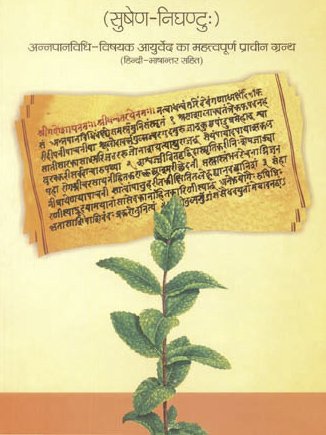Ashtaksharamantra, Aṣṭākṣaramantra, Ashtakshara-mantra: 3 definitions
Introduction:
Ashtaksharamantra means something in Hinduism, Sanskrit. If you want to know the exact meaning, history, etymology or English translation of this term then check out the descriptions on this page. Add your comment or reference to a book if you want to contribute to this summary article.
The Sanskrit term Aṣṭākṣaramantra can be transliterated into English as Astaksaramantra or Ashtaksharamantra, using the IAST transliteration scheme (?).
In Hinduism
Ayurveda (science of life)
Toxicology (Study and Treatment of poison)
Source: Shodhganga: Kasyapa Samhita—Text on Visha ChikitsaAṣṭākṣaramantra (अष्टाक्षरमन्त्र) is the name of a Mantra, as described in the Kāśyapa Saṃhitā: an ancient Sanskrit text from the Pāñcarātra tradition dealing with both Tantra and Viṣacikitsā—an important topic from Āyurveda which deals with the study of Toxicology (Viṣavidyā or Sarpavidyā).

Āyurveda (आयुर्वेद, ayurveda) is a branch of Indian science dealing with medicine, herbalism, taxology, anatomy, surgery, alchemy and related topics. Traditional practice of Āyurveda in ancient India dates back to at least the first millenium BC. Literature is commonly written in Sanskrit using various poetic metres.
Pancaratra (worship of Nārāyaṇa)
Source: archive.org: Catalogue of Pancaratra Agama TextsAṣṭākṣaramantra (अष्टाक्षरमन्त्र) is the name of a Mantra chanted during Śrīrāmanavamī (“Rāma’s birthday celebrations”), as discussed in the twenty-fifth chapter of the Agastyasaṃhitā (agastya-suīkṣṇa-saṃvāda edition), an ancient Pāñcarātra Āgama text dealing with the worship of Rāma, Sītā, Lakṣmaṇa and Hanumān.—[Cf. the chapter śrī-rāmanavamī-praśaṃsā]:—Every year in the caitra-month. on the ninth day when the constellation Punarvasu is there, the birthday of Rāma is to be remembered. Fasting and a vigil should be observed on the “ninth day,” as well as tarpaṇa-rites. Those who break the fast enjoined will go to hell. Alms-giving is also to be practised On the following day ( i.e., the “tenth day”), Rāma and His retinue should be meditated upon with the dvādaśa-mantra, and then worshipped thrice along with the aṣṭākṣaramantra. Such muttering of these powerful mantras is itself sufficient to yield great results. [...]
Source: Shodhganga: Kasyapa Samhita—Text on Visha Chikitsa (p)Aṣṭākṣaramantra (अष्टाक्षरमन्त्र) (or the Garuḍa-Aṣṭākṣara-Mantra) refers to one of the three Garuḍa-Saṃjñā-Mantras, according to the Kāśyapa Saṃhitā: an ancient Sanskrit text from the Pāñcarātra tradition dealing with both Tantra and Viṣacikitsā (Toxicology).—Kāśyapa gives the details of the Garuḍa-samjñāmantra which is composed of the words ‘vainateyāya namaḥ’ and concluding with praṇava as—Om Vainateyāya namaḥ om. The Ṛṣi of this mantra is Pulastya, metre is paṅkti; Garuḍa is the deity with ‘va’ as bīja; ‘namaḥ’ is said to be the śakti.

Pancaratra (पाञ्चरात्र, pāñcarātra) represents a tradition of Hinduism where Narayana is revered and worshipped. Closeley related to Vaishnavism, the Pancaratra literature includes various Agamas and tantras incorporating many Vaishnava philosophies.
See also (Relevant definitions)
Partial matches: Ashtakshara, Mantra.
Starts with: Ashtaksharamantravyakhya.
Full-text: Ashtakshara, Vyapakamantra, Samjnamantra, Shriramanavami, Ramanavami, Dvadashamantra, Shriramanavamiprashamsa.
Relevant text
Search found 2 books and stories containing Ashtaksharamantra, Aṣṭākṣaramantra, Aṣṭākṣara-mantra, Ashtakshara-mantra, Astaksaramantra, Astaksara-mantra; (plurals include: Ashtaksharamantras, Aṣṭākṣaramantras, mantras, Astaksaramantras). You can also click to the full overview containing English textual excerpts. Below are direct links for the most relevant articles:
Expiatory Rites in Keralite Tantra (by T. S. Syamkumar)
1.4. Expiatory Rites in Viṣṇusaṃhitā < [Chapter 3 - Expiatory Rites in Kerala Tantric Ritual Manuals]
2. Expiatory Rites in Vaiṣṇava Tantras < [Chapter 2 - Expiatory Rites in Āgamic Literature]
Parama Samhita (English translation) (by Krishnaswami Aiyangar)